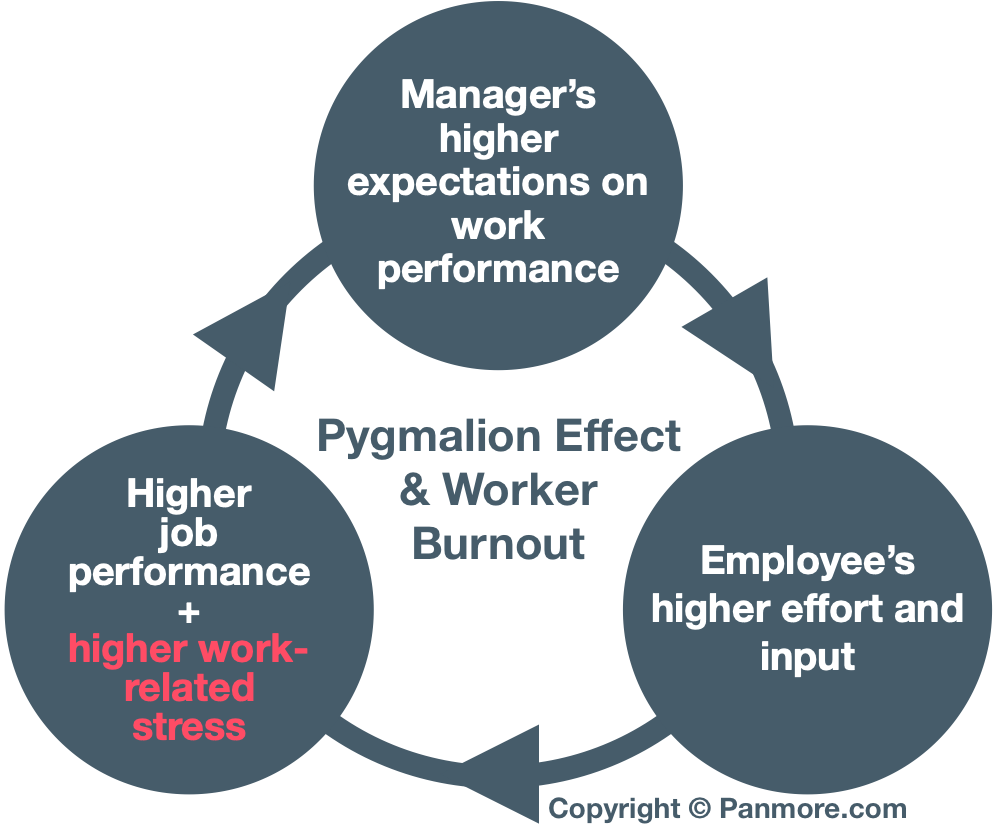
Employee burnout and work-related stress are linked to the Pygmalion effect of leaders’ expectations and influence in the workplace. Also known as the Rosenthal effect, the Pygmalion effect represents the psychological causal relationship between expectations and one’s behavior to fulfill such expectations. In this regard, the phenomenon is a self-fulfilling prophecy that leads to the fulfillment of leaders’ expectations. The strong association between expectations and actual subordinate behavior indicates significance in strategic management and strategic planning. This association is especially notable between leaders’ expectations and subordinates’ job performance. In addition, human resource management, employee behavior, job satisfaction, and morale relate the Pygmalion effect to employee burnout. Even though this relationship is not necessarily readily manifested and observed in organizational settings, it is essential that strategic management include programs, initiatives, policies, and procedures for optimizing the beneficial effects of the phenomenon, while also minimizing the associated risk of burnout among employees.
Regarding burnout in organizations, the Pygmalion effect is a positive feedback loop that increases or intensifies with each cycle. For example, higher expectations lead to higher performance, which in turn encourages even higher expectations. This phenomenon is the opposite of the Golem effect, which is another self-fulfilling prophecy that describes how lower expectations lead to lower performance, which then encourages even lower expectations.
The Pygmalion Effect (Rosenthal Effect) in Business Management and Strategy
In the context of business management, the Pygmalion effect applies to the performance of employees, relative to managers and leaders’ expectations. For example, when a manager communicates, verbally or otherwise, high expectations of a worker’s performance, the worker’s actual performance tends to increase to match the expectations. In human resource management, the Pygmalion effect represents a means for leaders to influence employee’s performance and, consequently, the organization’s performance. In the area of strategic management, this phenomenon links the expectations of leaders and managers to the achievement of strategies via support from the organization’s workforce. In this regard, business managers and strategists need to apply their understanding of the Pygmalion effect on leadership to positively influence workers and achieve business goals and strategic objectives.
Considering its occurrence in organizations and individual employee performance, the Pygmalion effect can be used to describe the performance of groups or teams, and even entire business organizations. The expectation-performance (or expectation-output) relationship applies to individuals, teams, groups, divisions, departments, and organizations through the psychological influence of leaders and managers on human resources. In this regard, organizational leaders must keep the Pygmalion effect in mind, especially in developing job requirements, expectations, and goals. The main objective should be to optimize the business organization’s performance by optimizing the positive effects of this phenomenon on the organization’s workers.
How the Pygmalion Effect Relates to Worker Burnout
Burnout happens when employees experience work-related stress that continues unresolved. This undesirable condition leads to low job performance, as well as low job satisfaction and low employee morale. This psychological nature links occupational burnout to the Pygmalion effect. The primary notion is that leaders’ excessively high expectations of subordinates can lead to excessive work-related stress that, when left unresolved, results in burnout. An employee becomes burned-out in the effort to meet leaders’ expectations and related goals and objectives that are too high, too difficult, or takes too much time to achieve. This problem continues when leaders overlook stress factors and narrowly focus on productivity, as presented in the following diagram of the Pygmalion effect or self-fulfilling prophecy relating to occupational burnout:

At the organizational level, executives implement strategies that typically aim for higher business performance, which corresponds to higher profitability and higher employee productivity. This goal is natural for businesses, but the means of achieving it is not always the optimal approach. For example, leaders’ expectations of an increase in productivity and profits could be too high for employees’ knowledge, skills, and abilities. As the Pygmalion effect indicates, this condition could lead to burnout. In very large organizations with hierarchical structures, this problem likely occurs when corporate headquarters do not have accurate knowledge about the capabilities and work-related stress levels of rank-and-file employees. Thus, to address the problem of burnout in relation to the Pygmalion effect, leaders must align organizational strategies, job performance requirements, and human resource capabilities.
Addressing Employee Burnout Linked to the Pygmalion Effect
Ensure realistic expectations. One of the main factors that lead to burnout linked to the Pygmalion effect or Rosenthal effect is the tendency of leaders and managers to have unrealistic expectations of employee performance, as well as their tendency to impose unrealistic requirements on workers. To prevent burnout, leaders must ensure that their expectations are realistic, relative to the actual capabilities of the workers involved. For example, such expectations should not lead to overwork, extended work hours in the office or at home, and the overloading of the tools (e.g., machines or systems) that are at employees’ disposal. Information technology used in the workplace can contribute to unrealistic expectations of higher productivity. Considering the Pygmalion effect, an analysis of workload using sociotechnical systems theory can help identify issues that lead to work overload and burnout.
Match actual input and performance with rewards. The Pygmalion effect illustrates that unrealistic expectations lead to workplace problems, such as work-related stress and employee burnout. In some cases where burnout happens, a possible culprit is the lack or insufficiency of rewards given to employees. Ideally, rewards match workers’ performance and input. This means that organizational managers must develop programs or compensation packages that commensurately reward employees for their effort and output. One should note that both effort and output are considered. Typical corporate managers tend to focus on output, without considering effort. However, based on the Pygmalion effect, compared to output, effort is more closely linked to work-related stress and occupational burnout. Efforts that go unrewarded become compounded, until the worker experiences exhaustion and burnout. By giving rewards that match output as well as effort, companies can reduce the risk of burnout that follows the Pygmalion effect of leaders’ and managers’ expectations on employees.
Facilitate task delegation. Managing the Pygmalion effect in relation to employee burnout requires maintaining realistic workloads. In the effort to meet leaders’ unrealistic expectations, employees could take and accept excessive workloads. These workloads impose the risk of overwork, exhaustion, and burnout. In this regard, in the context of the Pygmalion effect, an objective in addressing occupational burnout is to properly delegate tasks, so that no single employee is given an excessive workload. Task delegation is not a single complete solution to work-related stress and burnout, but it helps reduce the risk of burnout when employees tend to willfully take excessive workloads in the hope of satisfying their superiors.
Encourage employee feedback on performance, job satisfaction, and morale. Leaders need accurate information to properly assess the Pygmalion effect of their expectations on workers and their risk of burnout. In this regard, a factor in preventing or addressing employee burnout is to gather sufficient information regarding workers’ performance, job satisfaction, and morale, as well as other relevant information. For example, managers can use interviews or surveys that gather information about workers’ psychological wellness in the context of their jobs. It is advisable that leaders maintain openness to encourage truthful feedback from employees. This openness is closely linked to the company’s organizational culture. Thus, organizational culture programs are tools that shape how the Pygmalion effect influences employee burnout and business performance. Addressing the Pygmalion or Rosenthal effect and related issues, work culture and communication are used as strategic tools to optimize human resource performance in many large companies, like Apple, Google (Alphabet), Amazon, Tesla, and Disney, as well as Starbucks, McDonald’s, Walmart, and Nike. These multinational companies implement best practices in their organizational culture, feedback systems, and human resource management to prevent burnout and maximize employee performance.
Know when to stop. The Pygmalion effect links workers’ input and stress to managerial expectations and demands. Given this knowledge on the phenomenon, to prevent employee burnout, leaders need to ensure that they maintain a healthy level of expectations imposed on subordinates. Knowing when to stop increasing expectations, and stopping when appropriate can help reduce the risk of burnout. Considering the Pygmalion effect, this approach alone can effectively decrease the actual rates of burnout and related issues that impede workers and reduce workforce productivity. In strategic management pertaining to human resources, the approach should involve a process for determining employees’ work capacities, leaders’ expectations and strategic objectives, levels of work-related stress, and overall employee morale and job satisfaction. Assessing these factors relative to each other should indicate the suitability or non-suitability of leaders’ expectations and demands on the workers. This information should guide organizational change for adjusting these demands and expectations to reduce the risk of worker burnout illustrated through the Pygmalion effect. Regular implementation of this approach can minimize the occurrence of occupational burnout in the business organization.
References
- American Psychological Association – Coping with Stress at Work.
- Brockner, J., Chen, Y. R., & Zhu, G. (2024). The joint effects of perceived motivation and ability on work behaviors and attitudes: Integrating the past and shaping the future. Research in Organizational Behavior, 100208.
- Ellis, M. (2024). Evaluating leadership behaviors and their impact on employee morale: A comparative methodological analysis. Journal of Fundamental & Applied Business Research, 2(1), 3.
- Farasat, M., Gull, M., & Hassan, S. (2024). Unveiling the influence of Aesthetic Leadership: Enhancing employee self-efficacy through job-capabilities matching and the Pygmalion Effect. Remittances Review, 9(1), 3317-3337.
- Genedy, M., Hellerstedt, K., Naldi, L., & Wiklund, J. (2024). Growing pains in scale-ups: How scaling affects new venture employee burnout and job satisfaction. Journal of Business Venturing, 39(2), 106367.
- Occupational Safety and Health Administration – Workplace Stress.
- Xu, Y., & Farris, K. (2024). The influence of leadership styles and supervisor communication on employee burnout. Journal of General Management, 49(3), 169-179.